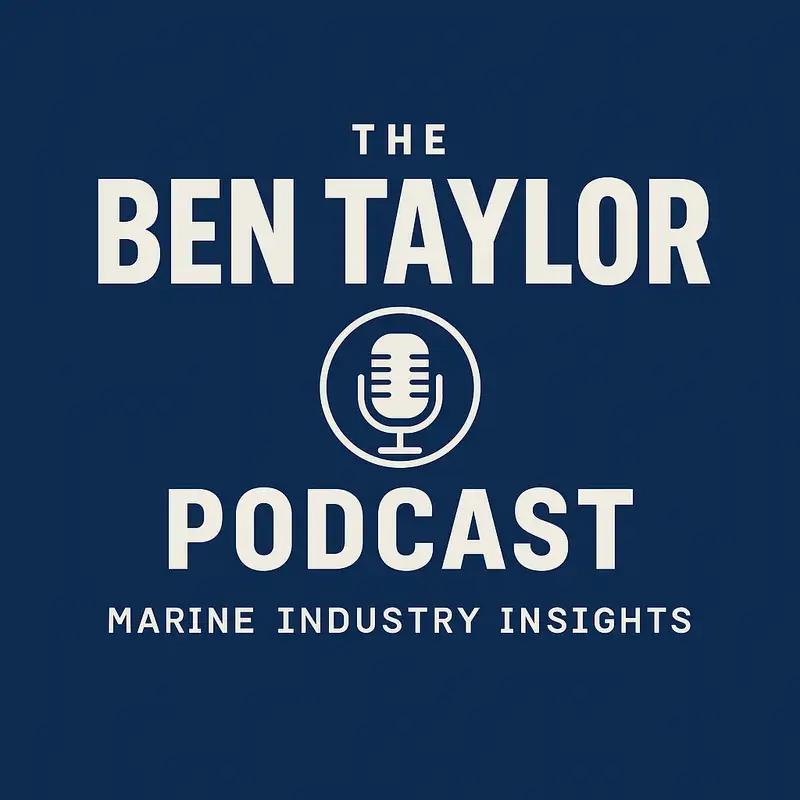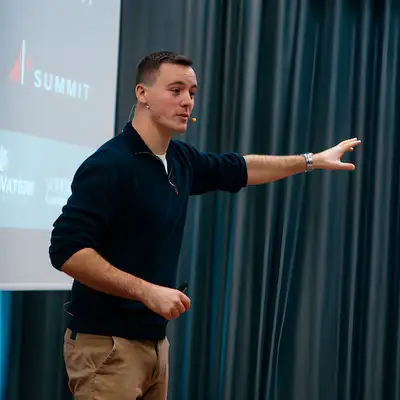
CATEPILLAR's Role in Superyachts & Energy Transition
It's already been engineered, the space within the engine room, everything, all the retrofitting later is already ready. This is the Ben Taylor podcast, the home of Marine Industry Insights, enjoy. Hi everybody and welcome back to another episode of the Ben Taylor podcast, the home of Marine Industry Insights. This is part of a series designed to profile the Australian yachting industry and find out a little bit about how it works. So today I'm here with Fred, nice to see you Fred. Thank you, thank you for having me. You're very very welcome. So let's have a bit of an introduction, who are you, what's your position, what company do you work for and what's the mission there? Sure, my name is Fred B. Camden and thanks again for having me here. I'm National Business Manager for the Marine Division at Energy Power Systems, authorised dealer for Caterpillar Marine in Australia. So if somebody is doing a turnkey power generation project, marine propulsion project or for that matter any kind of turnkey solution, or requiring a repower for marine, I look after the national segment for marine for Caterpillar in Australia. We are Caterpillar Australia basically, as an authorised dealer. I'm also the President of Australian Industry Defence Network, WA, very proud of that. I've taken that role more recently, it comes behind the passion of working in the industry and paying it back if you like. I've been in the marine industry for the last 25 years, I'm a marine engineer by trade. I've sailed at sea on bulk carriers and cargo tankers and whatnots, ULCCs, VLCCs. I migrated to Australia in 2007 and since then I've been through and through marine. It's basically been 15 years of the yellow colour of Caterpillar within myself. Okay, and what's Caterpillar's kind of niche where you're really, really powerful and dominant? What's the position that Caterpillar take within the yachting scene in Australia? Fantastic question. Well, around the world we are fairly well positioned from a super yachts perspective. You will appreciate that as we saw in the seminar today, that yachting manufacturing as such is fairly niche and we are very proud to have yachting manufacturers made in Australia, if I may, very passionate about that, to have Ecomarine and Ecoyachts as a member within the, if I may, the environment of the marine yachting industry within Australia. It's a very proud thing and I hail from Western Australia where Ecomarine is actually based and they happen to be one of our number one customers as far as marine commercial is concerned. Right, yeah, over in Perth and so what kind of projects do you typically get involved with and how does that all work? Where does that begin? How do you work almost as a partner, I imagine, throughout the whole project? Lovely question, I like it and if I'll reflect back on the fact that I mentioned Turnkey Solution. So Energy Power Systems Australia as a dealer for Caterpillar, born in 1994, we are about 33 years, if I got my maths right, we are about that old, three decades plus. Humble beginnings but we are fairly niche where in the environment of the Caterpillar marine and the larger Caterpillar group, we as a group are identified not only for marine but from a Turnkey Solution provider, integrator, problem solver, right from design, build, sea trials, commissioning, everything. Right, so when a project comes. From B2B solution, we do everything right from the design stage, vessel specification selection, what the engine is supposed to do, which engine is most suitable for which propulsion system and basically we are in the traditional diesel, we are hybrid, we are also looking at the electrification options, everything is there on the table. And are these a set number of products that are fairly rigid or do you work to build back the full integrated system and that kind of play? Again, I'll try to answer this in a candid way if I may. Yeah, please do. I know you're time-borne as well. It's basically, let's put it this way, right from 56 kilowatts all the way to 10 megawatts. Okay, 10 megawatts sounds pretty big. You're interviewing me in a very milestone-based year. Caterpillar turned 100 years on 15th of April and not very many people know that Catmarine as a group in Australia, we are fairly number one as far as defense is concerned. So from a segment perspective, application perspective, you'll appreciate Caterpillar is known for sustainability, ruggedness, reliability, performance, right? Right, so in the defense industry, those are the key pitch points. Absolutely, so from a workboat market, from a reliability market, from a charter boat market, from a ferry market, all the way to the superyacht market. Catmarine becomes really, really strong. Yes. And just that last bit's really interesting. So what's the crossover that you guys work with when you're supplying the military side? How does that crossover into the white boat side? Are they similar solutions? Are they quite different solutions that are needed or is it kind of a complementary sector? I'll touch base on one word, customer experience. It remains the same. The product changes color, the customer style approach slightly changes. You'll appreciate in a defense environment, a project starts from a tender phase, sometimes takes three to four years to be in a job. As much as the dollar effect is not that critical and I'm not going to be simplifying that from a defense side of things, it's very complex. Things take time to materialize. In the commercial boat market, one has to realize that time is money and it's important to be partnering and collaborating with the designer and the boat builder, making sure that they are getting the absolute value bang for the buck. If we pick it up or given our experience and runs on the boat that maybe we can guide the customer in a particular manner, we will and we won't apologize for saying how it is. One more thing we will not do is put the wrong engine or the wrong application in the wrong boat because goodwill is very important not only for ourselves, for our customer and for the end user. So the approach is fairly similar, the toss is fairly similar, it's just the yellow color. Let's put it say my white shirt would change into a black shirt which I'm wearing right now or vice versa depending on the audience. Okay and so what's the kind of vision looking forward? What's the expectation of this market? Is it something that you're optimistic about? Are there plenty of projects in the pipeline? Is it a little difficult at the moment? Are there supply chain issues? What's the situation? If this is a finale question, I'll answer it from a super yacht perspective. Yeah absolutely, that'd be great. To give you a perspective, having worked with Echo Marine and I will emphasize calling it Echo Yachts because it's a very important portion of their business. Chris Brackwell who's also on the board of the Australian ACMG and Super Yacht Australia. We have worked with them right from White Rabbit which is one of the largest super yachts in the world, built in Western Australia by Echo Marine, proudly powered by Caterpillar. Yes, Charlie Motor 1, 2, proudly powered by Caterpillar and now we're going to Charlie Motor 3 which is the brilliant sailboat that we saw and it was fantastic to see that the selections have been done and we are already part of it. Twin C18's main engines and two C7.1's recently been identified and C4.4. So it would be fantastic to see a full-blown semi-hybrid solution. Energy transition is a big thing for us as well and it's exciting that in a sailboat that we saw being featured, which is niche, it's one of the first, right? It's very niche, these unique projects bring engineering challenges as well. What gets more exciting is from an innovation perspective, since the last, I don't know exact number of years, but all the Caterpillar engines, majority of them can live and breathe on the dual fuel heavy vegetation oil, HVO and biodiesel oil already. So the engine selection and the genset selection that has been done for the sailboat, if I may, Charlie Motor 3, it's going to provide, if the customer wants, a fully green solution because our engines can live and breathe HVO and biodiesel today and we have the product available in the market. So actually, if we kind of summarize this, in the Australia market there's been past projects that are large substantial projects, there are also plenty in the pipeline being built today and actually you're pretty optimistic for the future in terms of the number of builds, the types of proportion solutions that are required, they're going to be fairly diverse, there's the kind of stronghold of traditional diesel engines but also the hybrid and fully electric, like it's all there and it's all looking... One thing, the biggest difference between defense and the future fuel energy transition in the marine commercial world, if somebody's putting iron on the ground in the workboat environment in the marine commercial or for that matter as we saw the sailboat, it's fantastic that people are thinking out of the box and thinking that if my vessel's life is 20 to 25 years, 30 years, up until the statutory... It's been ready for that, let's build it for that. We are also embarking on a journey, I won't name the customer for confidentiality reasons but we are part of potentially a vessel which will be based on a future fuel cell, I won't name the cell, proudly being done by a customer who has caterpillars in their boat, it's a ferry operator and we have embarked the journey where it's time, it's science stamped and sealed, the designer has actually designed the boat and the boat is now being built based on traditional caterpillar footprint on the reasoning that in the future, in the four to five years and in the scheme of things in energy transition, four to five years is nothing then, so when the footprint is available, when the equipment is available, it will be a straight swap. Right, be ready for it. And it's already been engineered, the space within the engine room, everything, all the retrofitting later is already ready. Okay, cool. So we potentially might be one of the first to be doing that in Australia, I'm quite confident of that. Well, what's that space? We'll come to know. Okay, let's finish up on that teaser. Thank you so much for your insights. My pleasure. Thank you. It's been a pleasure. Thanks for having me. Everybody, if you enjoy content like this and find it insightful, then make sure you're following here to see plenty more of it. All being well, we'll see you very soon. Bye for now. Thank you. Thank you for listening to another episode of the Ben Taylor podcast, the home of marine industry insights. We'll see you again very soon. Bye for now.
Creators and Guests
